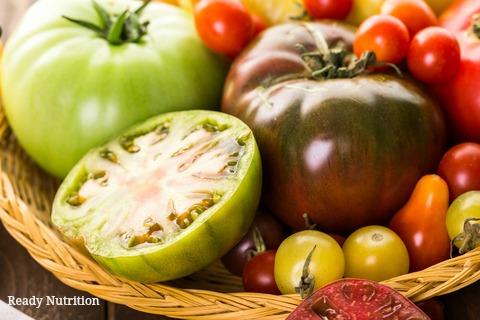
1. Choose the right location. Tomatoes love bright locations where they receive 10 hours or more of sunlight. Full morning sun is always the best location, but tomatoes will do well with some afternoon sun too. As well, ensure that you have properly spaced your plants.
- Dwarf varieties should be spaced about 12 inches apart in a row.
- If you are staking your plants, space them about 24 inches apart.
- Indeterminate tomatoes should be spaced about 36 to 48 inches apart.
2. Plant tomatoes in multiple locations. When you alternate where you plant your tomatoes, it helps to diminish the risk of soil-borne diseases such as bacterial spot and early blight. One of my favorite gardening resources, Carrots Love Tomatoes: The Secrets to Companion Planting taught me that when you plant companion plants near each other, it also helps to reduce soil-borne diseases, as well as, encourage beneficial bugs to hang around. Here is a list of companion plants for your tomatoes:
- Asparagus
- Basil
- Beans
- Borage
- Carrots
- Celery
- Dill
- Lettuce
- Melons
- Onions
- Parsley
- Peppers
- Radishes
- Spinach
- Thyme
3. Plant them deep! When you plant your tomato seedlings deep, it helps the plant develop a better root system. The extra roots will strengthen the plant so that it can support more fruit and survive hot weather. Gardeners recommend you planting your seedlings up to the first true leaves. If you have heavy soil and cannot dig your hole deeply, you can lay the plant on its side, and cover with dirt (ensure that the hole is at least 5 or 6 inches deep when buried).
4. Prune your tomatoes. I realize that many feel this step is optional, but it really helps. By pruning off any non-fruiting branches, it directs the tomato plant’s energy into growing more tomatoes. Every three weeks, I will prune my tomato plants in the early morning. Doing this step in the morning will help reduce any plant stress.
5. Fertilize! Tomatoes are heavy feeders and require lots of nutrients to produce all of those lovely tomatoes. Adding a layer of balanced organic fertilizer like 8-8-8 during the transplanting process will help shield plants from stress and encourage root growth. When plants begin to put out fruit, fertilize every two or three weeks with fertilizer and then water it in.
As well, consider giving your plants some compost tea. Compost tea takes the beneficial bacteria and fungus present in compost and exponentially increases them through aeration and sugars. These bacteria and fungus are critical in root establishment – and the more bacteria you have in your soil, the better. This all around plant booster helps foliage, increases root development, feeds the soil – you can’t go wrong! I usually make some compost tea once a month to help my plants.
6. Give them some support. Certain tomato varieties can grow over 6 feet high and will require a trellis, staking or tomato cage. The trellis system keeps ripe fruit off the ground, so it’s less susceptible to disease and is easier to harvest. Any garden center will have tomato cages and trellises. The best time to add stakes is during the time you are transplanting. This cuts down on damaging root systems later on.
7. Water them correctly. Last, but not least, is the most important tip of all – correct watering. Tomatoes need deep, yet infrequent watering. This helps cut down on tomato blight. As well, do your best to keep leaves dry.
8. Plant more! Succession planting in three-week intervals will keep you loaded with tomatoes throughout the growing season. As soon as you plant your seedlings, start a new batch of seeds. I usually plant tomatoes two or three times during the summer months.
9. Harvest as soon as they show their colors. Keep an eye on your growing tomatoes and harvest as soon as they color up fully. Birds and other wildlife love tomatoes as much as we do, so pick them as soon as their color comes. You can also pick your tomatoes a little early and allow it to ripen on your kitchen windowsill.
These tips will ensure that your tomato crop will be the best crop yet. Happy gardening!

Tess, what a tremendous list! Here in southern Ontario we generally plant our tomato seedlings the week after the May full moon. In other words, this is THE WEEK!
Last year a terrible blight nearly wiped out all of our heirloom tomatoes. June was soggy and damp and cool so the brown spots took over, but July was so dry, so hot and so sunny that it almost seemed to kill the blight faster than it could kill our plants.
Thanks for sharing your awesome tomato resource. I got lucky and interviewed 40 expert gardeners and compiled a big tips list of my own on BackToMyGarden if you’re open for more ideas.
This should be an amazing year for tomatoes, I hope you have a sensational summer Tess! You are appreciated!
David
Thank you, David! I hope your tomato crop was a good one this year. It’s amazing how much better the tomatoes grow by using these tips.